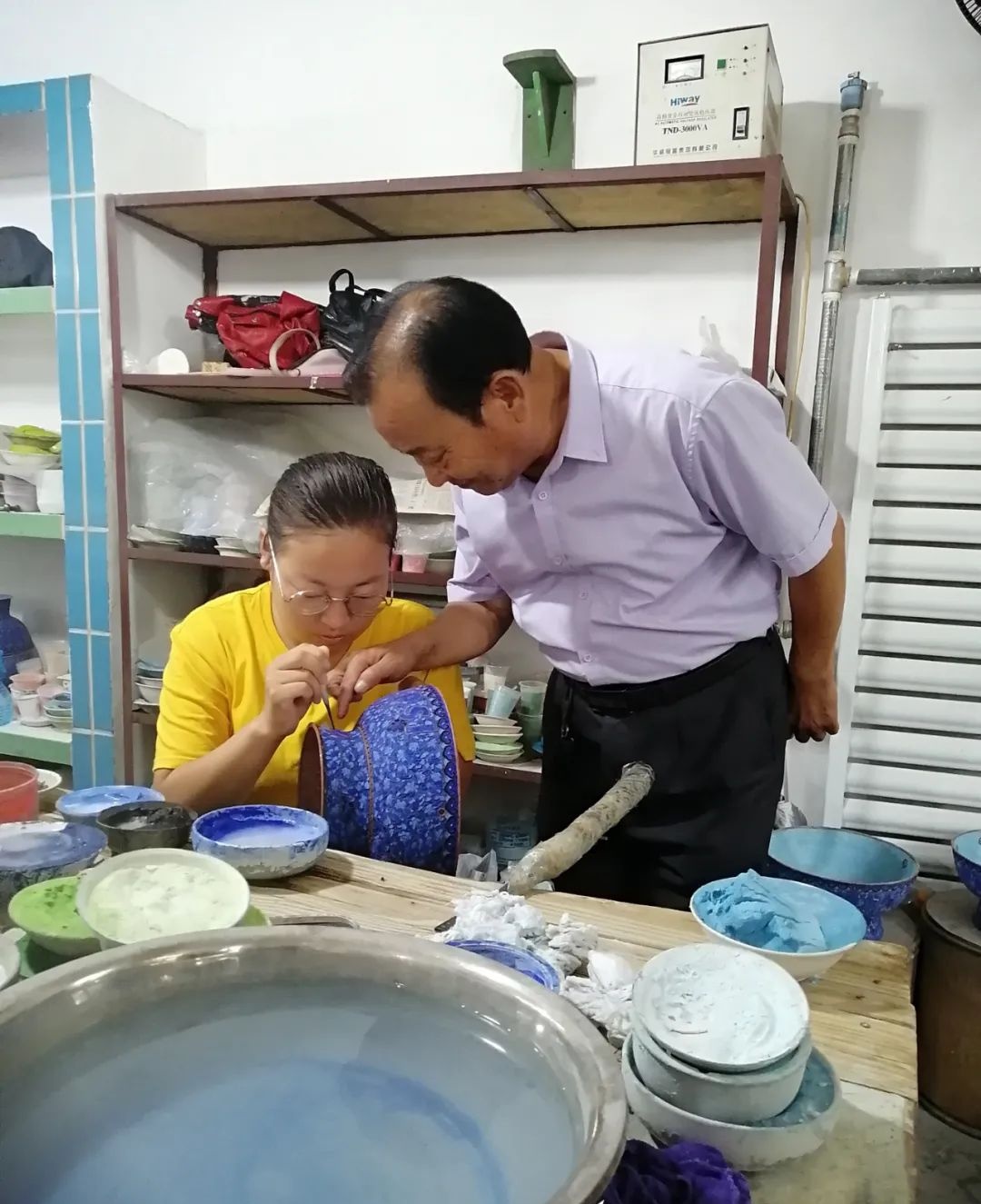Approaching Intangible Cultural Heritage: Cloisonné at Your Fingertips.
The swallows in front of the old Wang Xie Hall
fly into ordinary people's homes
Jingtai Blue, also known as "Copper-based filigree enamel", is a craftwork combining porcelain and copper. It is one of the "Four Famous Craftsmanship" in Chinese arts and crafts, along with jade, ivory carving, and lacquerware; Copper hot pot, a common dining utensil in northern China during winter. Jingtai Blue hot pot can be regarded as a tableware that combines artistic appreciation value and practical value.
This hot pot was originally a product used in the Qing Dynasty palace, but nowadays, it is a common thing to go to a restaurant to enjoy a meal of Jingtai Blue hot pot. This change is related to the times and is also connected with a court craftsman named Li Zinian from Laishui, Hebei.
Inherited by the family, this craftsmanship has gained new vitality in the new era.
Li Zenggui, the inheritor of Jingtai Blue hot pot making technique in Laishui, Hebei and a descendant of Li Zinian. Li Zenggui's skills have been passed down from generation to generation by his grandfather and great uncle.
My grandfather passed on this craft to my uncle after returning to his hometown, and he also established his own workshop in Nanqiaotou Village, Yongyang Town, Laishui County. During the war, all industries declined, and this craft also fell silent for a long time. Fortunately, with the rapid economic development after the reform and opening up, more and more people began to eat hot pot with copper pots in winter, and this craft regained its vitality. "Since the 1970s and 1980s, we have been cooperating with Beijing Donglaishun Restaurant, providing them with all the hot pot utensils. This also represents the industry's recognition of us," Li Zenggui said proudly.
The cloisonné hot pot is exquisitely made, incorporating both bronze and porcelain craftsmanship, as well as traditional hand painting and carving techniques, making it the epitome of traditional craftsmanship. It is precisely because of this that it particularly tests the craftsmanship of artisans. To fully master this technique, at least three years of systematic study is required. The production process of cloisonné hot pot mainly includes design, mold making, wire bending, wire soldering, enamel filling, enamel firing, polishing, and gold plating. Walking into the production workshop, workers in different production processes are busy. The originally ordinary purple copper material gradually transforms into exquisite cloisonné hot pots through various processes.

With technological innovation, he has endowed this technique with contemporary connotations.
After several generations of inheritance, Li Zenggui has innovated the production process of cloisonné hot pot.
The innovation of production techniques is one. Originally, the entire production process had to be done manually. With the advent of the mechanized era, the production of copper molds can now be done by machines, reducing workload and improving efficiency. The second is the improvement of durability. Although cloisonné hot pots have a long history, they have mostly been used as display items in the past. There aren't many people who actually use them as hot pot utensils. We have collaborated with Donglaishun to launch practical cloisonné hot pots. In order to enhance durability under high temperatures, we conducted repeated research and improvements, and finally presented beautiful and durable cloisonné hot pots to diners. The third is the innovation of material design. Like many art crafts, the patterns and designs of early cloisonné hot pots mainly featured traditional elements such as dragons and phoenixes. We have collaborated with the Laishui tourism department and creatively incorporated local historical and cultural elements such as Yanshan Wild Three Gorges and Zu Chongzhi into the designs. This not only enriches the content, but also promotes and showcases our hometown.
After the epidemic, like Li Zenggui, many colleagues in the town are facing the survival problem of a sharp decrease in orders. In the face of helplessness, Li Zenggui thought of a way to turn danger into opportunity: 'Nowadays, various places are promoting separate dining. We are thinking and designing single-person cloisonné hot pot and single-person cloisonné tableware, targeting new customer groups. I believe we will definitely win favor.' Over the years, in order to protect and inherit this skill, Li Zenggui passed on this skill to his two daughters and cultivated a group of professional technical personnel. Now, his company has 100 cloisonné production technicians, 8 senior technicians, 3 professional designers, and 1 provincial master. 'My factory was established in the 1970s. Over the decades, my apprentices have gradually grown into skilled technicians who can work independently. Now, except for occasional participation in individual design processes and quality control, I can confidently entrust them to handle the design and production.'

The prospects are optimistic, and there are more and more people who know and love cloisonné hot pot.
Many intangible cultural heritage inheritors are facing the problem of lack of successors, but Li Zenggui is different. He said, 'More and more people are becoming aware of and appreciating the art of cloisonné hotpot. This craftsmanship has brought good economic and social benefits. It allows us to work near our homes, without leaving our hometowns, and the income is relatively substantial. Therefore, it attracts more and more young people from Laishui to come and learn the art, injecting fresh blood into this industry.'
In recent years, cloisonné production enterprises represented by Li Zenggui's company have sprung up in Laishui like mushrooms, involving more than 30 villages including Yongyang Town. Nearly 200 companies in Laishui County are engaged in the production and sales of cloisonné hotpots, with nearly 10,000 employees, and many well-known brands have emerged, enhancing the industry's reputation.
'With the increasing frequency of cultural exchanges at home and abroad, not only Chinese people are fond of cloisonné hotpot, but also in many foreign countries, due to the influence of the local Chinese, cloisonné hotpot is loved by foreign friends. I think what attracts people is not only the delicious food, but also the traditional culture and aesthetic experience embodied in cloisonné,' said Li Zenggui.

